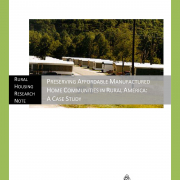HAC News: March 31, 2011
 https://appropriations.house.gov (go to the Agriculture Subcommittee page and click “Related Documents”). Written testimony from others will be accepted until April 14. Submission instructions are at https://appropriations.house.gov, or call staff, 202-225-2638.
https://appropriations.house.gov (go to the Agriculture Subcommittee page and click “Related Documents”). Written testimony from others will be accepted until April 14. Submission instructions are at https://appropriations.house.gov, or call staff, 202-225-2638.
GAO SUGGESTS IMPROVEMENTS IN FARM LABOR HOUSING PROGRAM. The Government Accountability Office examined demand for the Section 514/516 program, RD’s oversight processes, and existing properties’ financial status. Rural Housing Service: Opportunities Exist to Strengthen Farm Labor Housing Program Management and Oversight (GAO-11-329) is available free at https://www.gao.gov or for a fee from GAO, 866-801-7077.
DONATED MANUFACTURED HOMES FOR NATIVE AMERICANS ELIGIBLE FOR SECTION 502 LOANS. HUD is transferring free homes, donated by FEMA, to tribes. Section 502 loans can be used to cover transportation and set-up costs. An Unnumbered Letter dated March 14, 2011 reminds RD offices of requirements for manufactured homes and is available at https://www.rurdev.usda.gov/SupportDocuments/ulmarch11.pdf or from RD offices.
RD ENCOURAGES LOCAL OFFICES TO PARTNER FOR REPLACEMENT OF OLD MOBILE HOMES. Local offices are urged to support efforts by nonprofits and government entities to provide new manufactured housing to replace mobile homes built before the HUD Code came into effect in 1976. See Unnumbered Letter (March 15, 2011), available at https://www.rurdev.usda.gov/SupportDocuments/ulmarch11.pdf or from RD offices. Contact Christopher Ketner, RD, 202-690-1530, christopher.ketner@wdc.usda.gov.
USDA SECRETARY APPOINTS MINORITY ADVISORY COMMITTEE. The Minority Farmer Advisory Committee will help implement outreach and assistance efforts to socially disadvantaged farmers and ranchers, promote their participation in USDA programs, and support civil rights activities within the department. USDA’s press release is at https://content.govdelivery.com/bulletins/gd/USDAOC-52d34.
OMB REQUESTS COMMENTS ON COSTS AND BENEFITS OF REGULATIONS. Draft 2011 Report to Congress on the Benefits and Costs of Federal Regulations and Unfunded Mandates on State, Local, and Tribal Entities is available for review at https://www.whitehouse.gov/omb/inforeg_regpol_reports_congress/. Comments are particularly requested on how to improve retrospective analysis of existing rules, and are due May 16. See Federal Register, 4/1/11. Contact OMB, 202-395-3741.
RENTAL HOUSING DATA PROFILES FOR CONGRESSIONAL DISTRICTS UPDATED. The National Low Income Housing Coalition has added new data to provide snapshots of housing needs in each congressional district and state. The profiles include renter cost burden levels, overcrowding and incomplete plumbing rates, and more. Visit https://www.nlihc.org/detail/article.cfm?article_id=3810&id=61.
RURAL VOICES FEATURES SELF-HELP SUCCESSES. A special edition of HAC’s quarterly magazine describes the benefits of USDA’s Section 523 self-help housing program coupled with Section 502 direct mortgages. Current and past issues of Rural Voices are free at https://ruralhome.org. One print subscription per organization is free from Dan Stern, HAC, 202-842-8600, dan@ruralhome.org.
GET THE HAC NEWS SOONER – GET IT BY EMAIL. To subscribe, visit https://lists.ruralhome.org/lists/info/hac_news. To be removed from the postal mailing list, send a request to dan@ruralhome.org.

